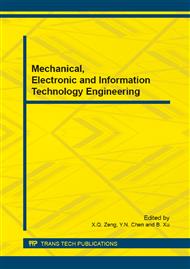p.49
p.55
p.61
p.66
p.71
p.79
p.85
p.91
p.99
Kinematic Error Analysis of Parallel Machine Tool Based on Rigid Body Dynamics
Abstract:
To estimate influence of velocity on kinematic accuracy for a cross-linked Stewart type Parallel Machine Tool, position and orientation errors of the moving tool platform are researched. Based on rigid body dynamics, inertial and friction forces and moments are considered. Firstly, analytical expression of driving force is derived for each link. Secondly, change of length is derived using Hooke’s Law for each link. Then mapping matrix between change of link length and change of platform position and orientation is derived based on both Euler angle and revolving angle around a spatial axis. Finally, analytical expression of position and orientation errors of the moving platform is derived. Figures of distribution of position and orientation errors in workspace under two velocities are obtained respectively. The results show that, in frequently used workspace, all of the three components of position error are less than 3.5μm. All of them increase with z coordinate of platform center. Position error is influenced slightly by velocity. The difference of position error between two velocities is less than 2%.
Info:
Periodical:
Pages:
71-78
Citation:
Online since:
March 2015
Authors:
Keywords:
Price:
Сopyright:
© 2015 Trans Tech Publications Ltd. All Rights Reserved
Share:
Citation:


